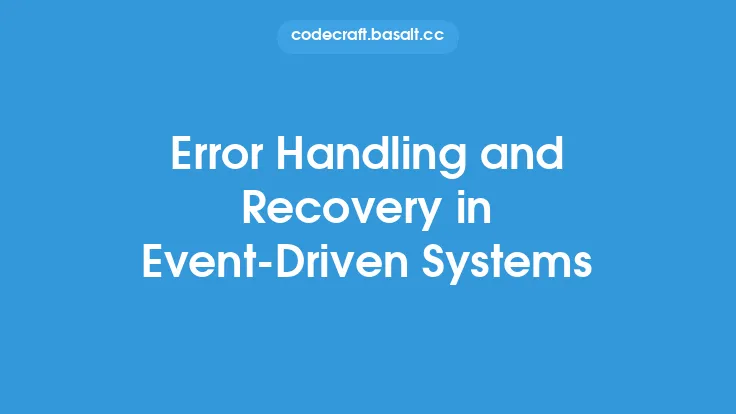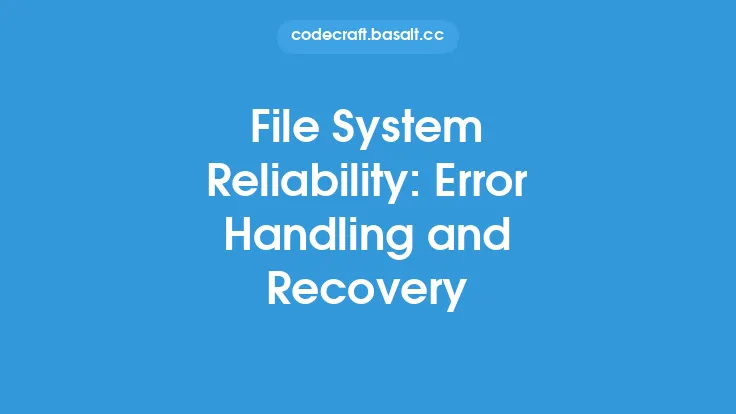Error handling and recovery in I/O operations are critical components of robust system design, ensuring that systems can withstand and recover from errors, faults, and failures that may occur during input/output operations. I/O operations are a fundamental aspect of computer systems, enabling data exchange between devices, peripherals, and the system itself. However, I/O operations are also prone to errors, which can have significant consequences, including data loss, system crashes, and security breaches. In this article, we will delve into the importance of error handling and recovery in I/O operations, exploring the types of errors that can occur, the techniques used to handle and recover from these errors, and the best practices for implementing robust error handling and recovery mechanisms.
Introduction to I/O Errors
I/O errors can occur due to various reasons, including hardware failures, software bugs, and external factors such as power outages or network connectivity issues. These errors can be categorized into several types, including:
- Hardware errors: These errors occur due to hardware failures, such as disk crashes, network interface card failures, or peripheral device malfunctions.
- Software errors: These errors occur due to software bugs, such as incorrect device driver implementations, faulty firmware, or operating system errors.
- External errors: These errors occur due to external factors, such as power outages, network connectivity issues, or user errors.
Error Handling Techniques
Error handling techniques are used to detect, report, and recover from I/O errors. These techniques can be categorized into several types, including:
- Error detection: This involves detecting errors as they occur, using techniques such as checksums, cyclic redundancy checks (CRCs), or error-correcting codes.
- Error reporting: This involves reporting errors to the operating system, application, or user, using techniques such as error codes, log messages, or alert notifications.
- Error recovery: This involves recovering from errors, using techniques such as retrying failed operations, restoring data from backups, or using redundant systems.
Error Recovery Mechanisms
Error recovery mechanisms are used to recover from I/O errors, ensuring that systems can continue to operate normally. These mechanisms can be categorized into several types, including:
- Retry mechanisms: These mechanisms involve retrying failed I/O operations, using techniques such as exponential backoff or retry limits.
- Redundancy mechanisms: These mechanisms involve using redundant systems, such as redundant array of independent disks (RAID) or redundant network interfaces, to ensure continued operation in the event of a failure.
- Backup and restore mechanisms: These mechanisms involve restoring data from backups, using techniques such as full backups, incremental backups, or differential backups.
Best Practices for Error Handling and Recovery
Best practices for error handling and recovery involve implementing robust error handling and recovery mechanisms, using techniques such as:
- Error handling frameworks: These frameworks provide a structured approach to error handling, using techniques such as error codes, exception handling, or error callbacks.
- Redundancy and failover: These techniques involve using redundant systems and failover mechanisms to ensure continued operation in the event of a failure.
- Backup and disaster recovery: These techniques involve restoring data from backups and recovering from disasters, using techniques such as full backups, incremental backups, or differential backups.
Implementation Considerations
Implementing error handling and recovery mechanisms requires careful consideration of several factors, including:
- Performance overhead: Error handling and recovery mechanisms can introduce performance overhead, which must be carefully managed to ensure optimal system performance.
- Security implications: Error handling and recovery mechanisms can have security implications, which must be carefully considered to ensure the security and integrity of the system.
- Scalability and reliability: Error handling and recovery mechanisms must be designed to scale with the system, ensuring reliable operation even in the event of failures or errors.
Conclusion
Error handling and recovery in I/O operations are critical components of robust system design, ensuring that systems can withstand and recover from errors, faults, and failures that may occur during input/output operations. By understanding the types of errors that can occur, the techniques used to handle and recover from these errors, and the best practices for implementing robust error handling and recovery mechanisms, system designers and developers can create robust and reliable systems that can operate effectively even in the presence of errors or failures.





